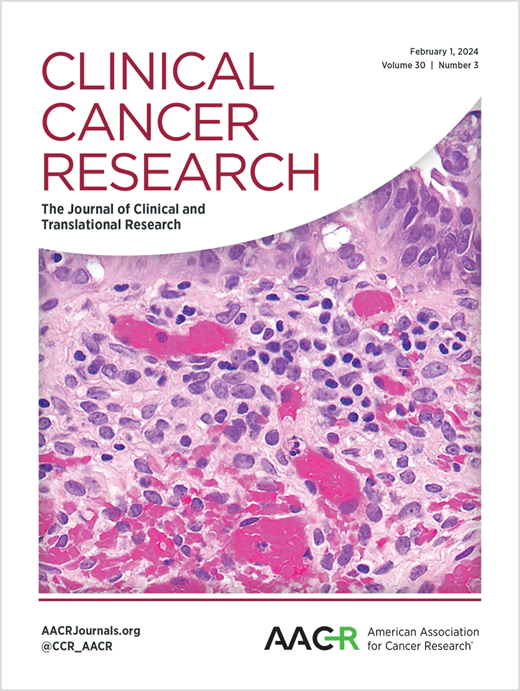CAR - t细胞治疗弥漫性大B细胞淋巴瘤后骨骼肌减少和骨骼肌损失
IF 10
1区 医学
Q1 ONCOLOGY
引用次数: 0
摘要
目的:肌肉减少症是癌症恶病质的标志。嵌合抗原受体(CAR) t细胞治疗与可能加剧肌肉减少症的炎症状态有关。CAR - t细胞治疗、肌肉减少症和代谢之间的关系尚不清楚。实验设计:在83例大b细胞淋巴瘤患者中,骨骼肌指数(SMI)从基线和治疗后30天和90天获得的临床图像中测量。前4周进行血清代谢组学(n=57例)。结果:超过一半的患者存在基线肌少症,并且与非肌少症患者相比,中位总生存期(OS)较短(10.5个月对34.3个月;P = 0.006)。这种减少是由于非复发死亡率(NRM)增加,所有六种NRM事件都发生在基线肌少症患者中。在CAR - t细胞治疗后的前30天,1/3的患者骨骼肌损失大于10%。肌肉损失与较高的肿瘤负荷和神经毒性相关,但与长期生存无显著相关性。血清代谢组学显示早期(1-2周)嘌呤代谢物升高,随后(3-4周)甘油三酯水平升高。与基线相比,血清代谢物增幅最大的是己二酸,这归因于住院患者的果冻和其他酸饮料菜单。结论:CAR - t细胞治疗后骨骼肌损失是常见的,并且与脂肪酸分解代谢有关。基线肌少症患者耐受性差,生存率降低。未来对饮食和运动干预的研究可能会改善CAR - t细胞治疗的结果。本文章由计算机程序翻译,如有差异,请以英文原文为准。
Sarcopenia and Skeletal Muscle Loss after CAR T-cell Therapy in Diffuse Large B cell Lymphoma
Purpose: Sarcopenia is a hallmark of cancer cachexia. Chimeric antigen receptor (CAR) T-cell therapy is associated with an inflammatory state that may exacerbate sarcopenia. The relationship between CAR T-cell therapy, sarcopenia, and metabolism is poorly understood. Experimental Design: In 83 large B-cell lymphoma patients, the skeletal muscle index (SMI) was measured from clinical images obtained at baseline and days 30 and 90 post-therapy. Serum metabolomics (n=57 patients) was performed in the first 4 weeks. Results: Baseline sarcopenia was present in over half of patients and associated with shorter median overall survival (OS) than for non-sarcopenic patients (10.5 versus 34.3 months; P=0.006). This reduction was due to increased non-relapse mortality (NRM) with all six NRM events occurring in patients with baseline sarcopenia. In the first 30 days after CAR T-cell therapy, 1/3 of patients experienced skeletal muscle loss greater than 10%. Muscle loss was associated with higher tumor burden and neurotoxicity but was not significantly associated with long term survival. Serum metabolomics revealed an early (weeks 1-2) increase in purine metabolites, followed by a later (weeks 3-4) increase in triglyceride levels. The serum metabolite with the highest fold-increase from baseline was adipic acid, attributed to the inpatient hospital menu of Jello and other tart beverages. Conclusions: Skeletal muscle loss after CAR T-cell therapy is common and is associated with fatty acid catabolism. Patients with baseline sarcopenia have poor tolerance and reduced survival. Future studies of dietary and exercise interventions may improve CAR T-cell therapy outcomes.
求助全文
通过发布文献求助,成功后即可免费获取论文全文。
去求助
来源期刊

Clinical Cancer Research
医学-肿瘤学
CiteScore
20.10
自引率
1.70%
发文量
1207
审稿时长
2.1 months
期刊介绍:
Clinical Cancer Research is a journal focusing on groundbreaking research in cancer, specifically in the areas where the laboratory and the clinic intersect. Our primary interest lies in clinical trials that investigate novel treatments, accompanied by research on pharmacology, molecular alterations, and biomarkers that can predict response or resistance to these treatments. Furthermore, we prioritize laboratory and animal studies that explore new drugs and targeted agents with the potential to advance to clinical trials. We also encourage research on targetable mechanisms of cancer development, progression, and metastasis.
 求助内容:
求助内容: 应助结果提醒方式:
应助结果提醒方式:


